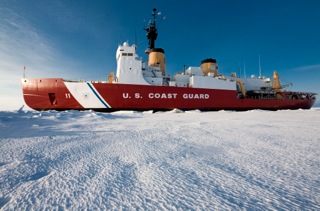Warming Arctic waters will result in greater opportunities for marine businesses to thrive, especially those involved in commercial shipping and transportation services, according to U.S. Sen. Angus King, I-Maine. But to maximize those opportunities, the country must up its investments in infrastructure such as icebreakers, King said.
Building more icebreakers “has to be part of national policy,” King said at his Dec. 4 appearance at the Mid-Coast Forum on Foreign Relations. Without icebreakers, which he called “the roadbuilders of the Arctic,” the U.S. is “on the sidelines” as other countries — Russia in particular — build up their fleets and their sovereignty claims in the area.
“They’re expensive - they’re about $1 billion apiece. But if this is going to be an expanded opportunity...It’s like saying we want to develop Maine but we’re not going to build any roads,” King said. “Infrastructure has to be part of what we do and infrastructure in this case is all about icebreakers.”
An average of 100 to 300 commercial ships navigated through Arctic waters between Asia, Scandinavia and North America over each of the past three summer seasons. That’s a small amount of traffic compared to more popular (and less icy) southern routes, but in the next 10 to 20 years, Arctic waterways should become much more navigable as water temperatures rise due to global warming.
King said his involvement in Arctic issues primarily stems from the potential benefit his home state could gain from the opening of the Northwest Passage — a shorter route between Asia and the U.S. eastern seaboard that stands to gain traffic as sea ice melts. As ships taking the Northwest Passage from Asia sail south from Arctic waters, the first U.S. ports they pass are Eastport, Searsport and Portland — all in Maine.
“Maine has some significant opportunity here which is already manifesting itself,” he said, referencing the decision by the Icelandic shipping company Eimskip to move its U.S. operations center from Virginia to Portland in 2013 and its recent expansion of its use of Portland as an entry port for European goods.
That’s just the tip of the iceberg, said Patrick Arnold, the director of business development, marketing and operations for the Maine Port Authority, which operates the terminal used by Eimskip in Portland. While Arnold said he doesn’t immediately expect Maine to become a major destination for large oceangoing container ships, which will likely head further south to larger U.S. ports, he believes the state can still benefit if it focuses on niche and secondary markets related to Arctic trade, citing Eimskip as one example.
“Expanding the trade pipeline through the Arctic will inevitably lead to more coastal and local trade opportunities,” Arnold said. He said there will “definitely” be a role to play for local commercial watercraft, such as articulated tug and tow barges.
Arnold cited Maine’s recent and planned future multimillion-dollar investment in port expansion and improvements such as the construction of intermodal and cold storage facilities as a good start, but called the need for more icebreakers the “lynchpin” to opening up the state to more Arctic trade opportunities.
“The point of the icebreakers, besides opening up these major commerce routes, is that they give us a seat at the table when it comes to discussions on Arctic trade,” Arnold said. “We have no role to play without icebreakers.”




